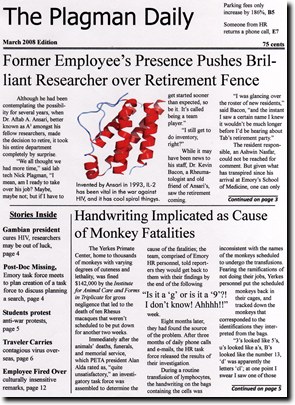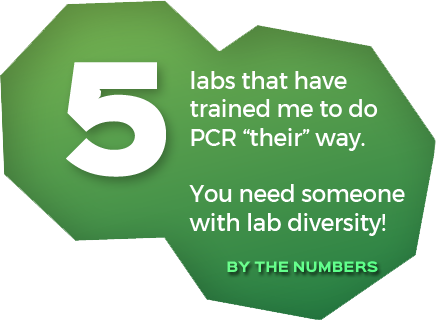
4x Expected Production, $30k in Savings (in 8 weeks)
I was hired to perform 2 sensitivity assays each day. But that didn’t
make sense. I was being taught to make 20ml of each solution (10ml
per plate) in a 50ml conical. But a 50ml conical holds 50ml. Why not
make 40ml of each solution and do 4 patients instead? I did, and I
would finish the four sets by lunch.
I also calculated that, because I was using half the number of 50ml
conicals by doing four instead of two at a time, we were saving over
$30,000/year.
Given how much I’ve learned since then, I probably would’ve found
an even more efficient, more cost-effective alternative to the conicals.
That’s what I excel at (and enjoy). For instance, my previous lab was
using 15ml BD Falcon conicals as serum collection tubes. Mind you,
there was never more than 3 or 4 milliliters of serum, so the 15ml
capacity was completely unnecessary.
But more importantly, a case of 500 of those runs about $250, making
each tube worth fifty cents. May not seem like much, but why not use
5ml transport tubes from Karter Scientific that cost $33 for 1,000? Each
kit now cost 49.967 cents less. That was an easy one, I admit; I was just
trying to stay with the conical theme. And again keeping with that
theme, did I ever tell you about the time I got a certain brand name
50ml conical with a certain convenient feature for less than half of list
price?

Reverse-Transcriptase Real-Time PCR Assay for the Win
The Emory Pathology department was my first lab job that would last more than a few months, and it’s where I undertook my first real
inventory assignment.
The PI of my lab had been collecting tubes in liquid nitrogen since the
90s. Spread out over a dozen racks in three tanks, they realized they
needed to know what they actually had (because they were running
out of room for new stuff, and because I said I could take care of it).
So I took care of it. What’s funny is that I can remember going to bed
thinking about how I couldn’t wait to get back to logging those samples
(one-by-one). And it wouldn’t be easy – my French boss’ nines looked
exactly like lowercase g’s. Cryovials that had been sitting at -180ºC for a
decade wouldn’t possess the most legible handwriting to begin with,
much less when 3’s were probably 5’s and what looked like the letter B
was actually 13.
Quantitative RT RT-PCR Viral Load Assay
But one of my greatest laboratory accomplishments, that is still paying dividends to this day, is how I was able to successfully develop a protocol to detect viral loads via quantitative RT RT-PCR. In fairness, the idea to do so wasn’t mine, I’m just the one who made it work after so many had tried before me. My secret? I knew very little about any part of the proposed protocol. I had no biases – I was open to anything.I don’t remember how I settled on Sigma’s Avian RT First Strand Synthesis Kit, but I do remember the Sigma sales rep spending a substantial amount of time teaching me how to troubleshoot PCR.
I also don’t remember how I decided to go with SYBR Green. But after tweaking various parts of the protocol, the combination worked (including thea home-made RNA extraction), and viral loads could all be done in-house. It became my specialty, and I reached my pinnacle of motivation – I became indispensible.
Ironically, I’m probably the most loyal and dedicated person of all-time (well, maybe not #1, but at least in the top 10). Yet, I’ve worked in 7 different labs. But in truth, I thought my last job would be my last job. I was very, very wrong. But I know for a fact I'll never come across another lab - or business - quite like that one. Thus, I believe, and hope, my next job will be my last job.
WHAT IS THIS SECTION?
Whatever I'm put in charge of is going to be a finely-tuned machine running at peak efficiency and unprecedented cost-effectiveness. How can I make such a statement? One, because it's a fact, and two, because I won't rest until I've achieved that status.

Just for fun, I made a fake newspaper about our little pathology group.
Click the image or this text or this box-like thing to open it in a new tab. It's pretty much one of the funniest fake newspapers of all-time.



